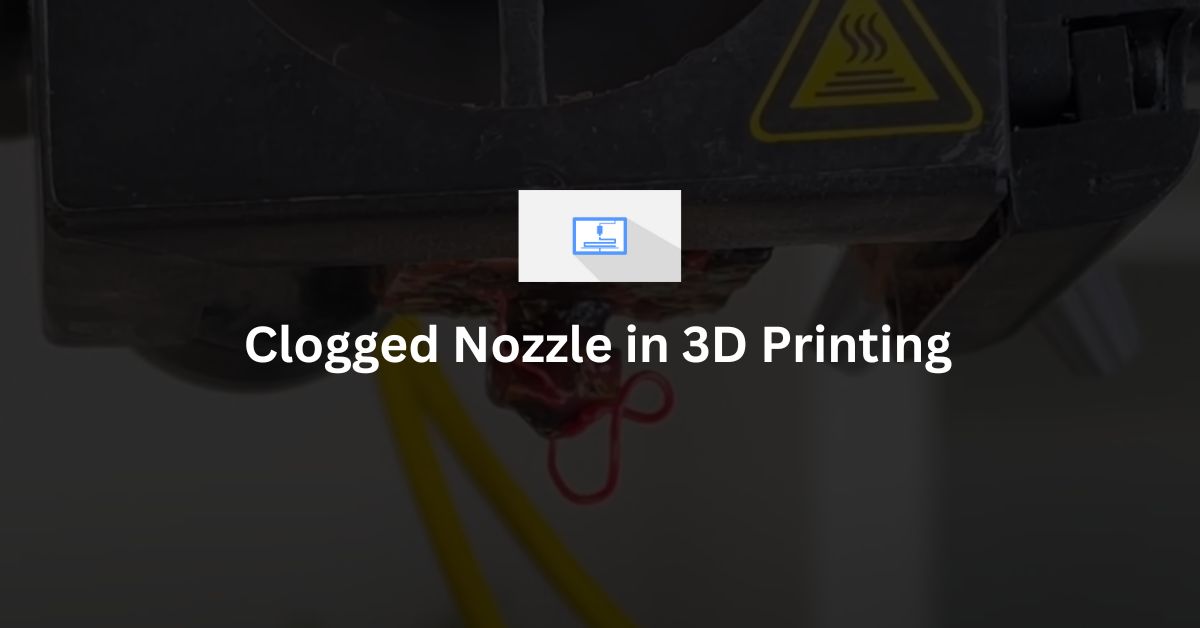Clogged Nozzle in 3D Printing – 3D printers can sometimes have problems. Clogged nozzle is a very common issue in fdm 3d printing.
3D printing is a fascinating technology that lets us make almost anything, from toys to tools, by creating objects layer by layer using melted plastic.
In this blog post, I will discuss what a clogged nozzle is, why it happens, and how to fix it.
What is a Nozzle in a 3D Printer?
The nozzle is a small, cone-shaped part at the end of the 3D printer’s extruder. It’s where the melted plastic comes out to form the layers of the object you are printing. Think of it like the tip of a glue gun—when everything is working well, the plastic flows smoothly through the nozzle and onto the print bed.
What is a Clogged Nozzle?
A clogged nozzle happens when something blocks the flow of melted plastic, stopping it from coming out smoothly. This blockage can cause the printer to stop working or make the print quality very poor, with gaps, missing layers, or rough surfaces.
Why Do Nozzles Get Clogged?
There are several reasons why a nozzle might get clogged:
- Dirty or Dusty Filament: Filament is the plastic material used in 3D printing. If the filament is dirty or dusty, it can carry small particles into the nozzle, which can build up and cause a blockage.
- Low-Quality Filament: Low-quality filament may contain impurities or inconsistent thickness, which can cause clogs.
- Incorrect Temperature Settings: If the nozzle is not hot enough, the filament might not melt properly and can get stuck in the nozzle. On the other hand, if the nozzle is too hot, the filament can burn and leave behind residue that clogs the nozzle.
- Filament Left in the Nozzle: When the printer is not in use, if the filament is left inside the nozzle, it can cool down and harden. This can lead to clogs.
- Dust or Debris Inside the Printer: If there is dust or small debris inside the printer, it can find its way into the nozzle and cause a clog.
How to Prevent Nozzle Clogs
Prevention is always better than fixing a problem. Here are some simple steps to avoid nozzle clogs:
- Use High-Quality Filament: Investing in good quality filament can prevent many common problems, including clogs. High-quality filaments are more consistent in diameter and contain fewer impurities.
- Store Filament Properly: Keep your filament clean and dry. Store it in a sealed bag with a desiccant packet to avoid moisture and dust.
- Clean the Nozzle Regularly: Use a nozzle cleaning tool or needle to keep the nozzle clean. Regular maintenance and cleaning nozzle can help prevent clogs from forming.
- Check Temperature Settings: Always use the recommended temperature settings for your filament. Check the manufacturer’s instructions to know the right temperature range for printing.
- Unload Filament When Not in Use: When you’re done printing, unload the filament from the nozzle to prevent it from cooling and hardening inside.
How to Fix a Clogged Nozzle?
If you suspect your nozzle is clogged, don’t worry! Below are some steps to fix it:
- Manual Cleaning with a Needle: Gently insert a small needle or a piece of wire into the nozzle to clear any blockages.
- Cold Pull Method: Heat the nozzle to the recommended temperature for your filament, push some filament through, and then let it cool down slightly. Quickly pull the filament out while it’s still soft. This can help pull out any debris or clogs inside.
- Heat the Nozzle to a Higher Temperature: Sometimes, heating the nozzle to a higher temperature can melt the clog, allowing it to flow out. Be cautious not to overheat and damage your printer.
- Disassemble and Clean the Nozzle: If the clog is severe, you may need to remove the nozzle and soak it in a solvent that dissolves plastic. Then, use a brush or needle to clear out the blockage.
- Replace the Nozzle: If cleaning doesn’t work, consider replacing the nozzle with a new one. Nozzles are relatively inexpensive and easy to get a new one and replace the old one.
Conclusion
Clogged nozzles are a common issue in 3D printing, but with a little care and maintenance, you can prevent them from happening. By using high-quality filament, keeping your printer clean, and following the proper procedures, you can ensure smooth printing and high-quality results.
If you do encounter a clog, don’t panic—just follow the steps above, and you’ll be back to printing in no time!
Happy printing!
Defects in FDM 3D Printing
